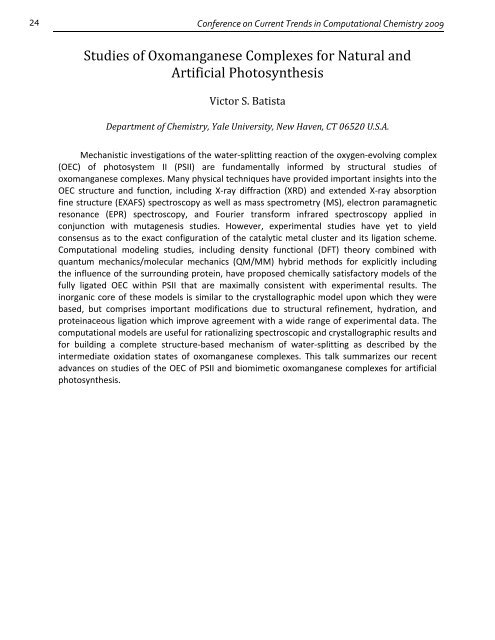Proceedings - Interdisciplinary Center for Nanotoxicity
Proceedings - Interdisciplinary Center for Nanotoxicity
Proceedings - Interdisciplinary Center for Nanotoxicity
Create successful ePaper yourself
Turn your PDF publications into a flip-book with our unique Google optimized e-Paper software.
24<br />
Conference on Current Trends in Computational Chemistry 2009<br />
Studies of Oxomanganese Complexes <strong>for</strong> Natural and<br />
Artificial Photosynthesis<br />
Victor S. Batista<br />
Department of Chemistry, Yale University, New Haven, CT 06520 U.S.A.<br />
Mechanistic investigations of the water‐splitting reaction of the oxygen‐evolving complex<br />
(OEC) of photosystem II (PSII) are fundamentally in<strong>for</strong>med by structural studies of<br />
oxomanganese complexes. Many physical techniques have provided important insights into the<br />
OEC structure and function, including X‐ray diffraction (XRD) and extended X‐ray absorption<br />
fine structure (EXAFS) spectroscopy as well as mass spectrometry (MS), electron paramagnetic<br />
resonance (EPR) spectroscopy, and Fourier trans<strong>for</strong>m infrared spectroscopy applied in<br />
conjunction with mutagenesis studies. However, experimental studies have yet to yield<br />
consensus as to the exact configuration of the catalytic metal cluster and its ligation scheme.<br />
Computational modeling studies, including density functional (DFT) theory combined with<br />
quantum mechanics/molecular mechanics (QM/MM) hybrid methods <strong>for</strong> explicitly including<br />
the influence of the surrounding protein, have proposed chemically satisfactory models of the<br />
fully ligated OEC within PSII that are maximally consistent with experimental results. The<br />
inorganic core of these models is similar to the crystallographic model upon which they were<br />
based, but comprises important modifications due to structural refinement, hydration, and<br />
proteinaceous ligation which improve agreement with a wide range of experimental data. The<br />
computational models are useful <strong>for</strong> rationalizing spectroscopic and crystallographic results and<br />
<strong>for</strong> building a complete structure‐based mechanism of water‐splitting as described by the<br />
intermediate oxidation states of oxomanganese complexes. This talk summarizes our recent<br />
advances on studies of the OEC of PSII and biomimetic oxomanganese complexes <strong>for</strong> artificial<br />
photosynthesis.



